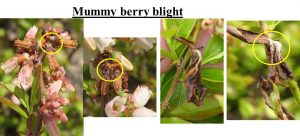Time to look for symptoms of Mummy berry and Botrytis flower blight
Mummy berry infections are finished in most areas in Maine since the mummy berry cups have dried up and are no longer producing spores. If you have a very late developing field you may have some chance of infection if there are still cups in your field.
We are starting to see symptoms of mummy berry infection in fields in the Midcoast and Downeast regions. Infected tissues will have the middle of the leaf turn brown and then the rest of the leaf will die and the whole branch curl downwards. Flowers will die before they open. Both diseased flowers and leaves will produce grey spores at their base. These spores are carried by pollinators and other insects to healthy flowers to infect the fruit as it develops. By the time you see the spore production, the fungus has probably already spread to the flowers so applying fungicides when you see infected tissues is not recommended. The symptoms will continue to develop over the next two weeks or so and then dead tissue with mummy berry blight symptoms will fall off of the plants.

Botrytis blight typically infects almost open (pink bud stage) or open flowers and kills those flowers typically when they are open. The grey spore masses are produced on black hairs that are seen on the dead tissue even after the spores have spread. Now is the time to scout your clones for Botrytis symptoms. The rainfall predicted this weekend may cause Botrytis infections in fields that already have Botrytis infections.

